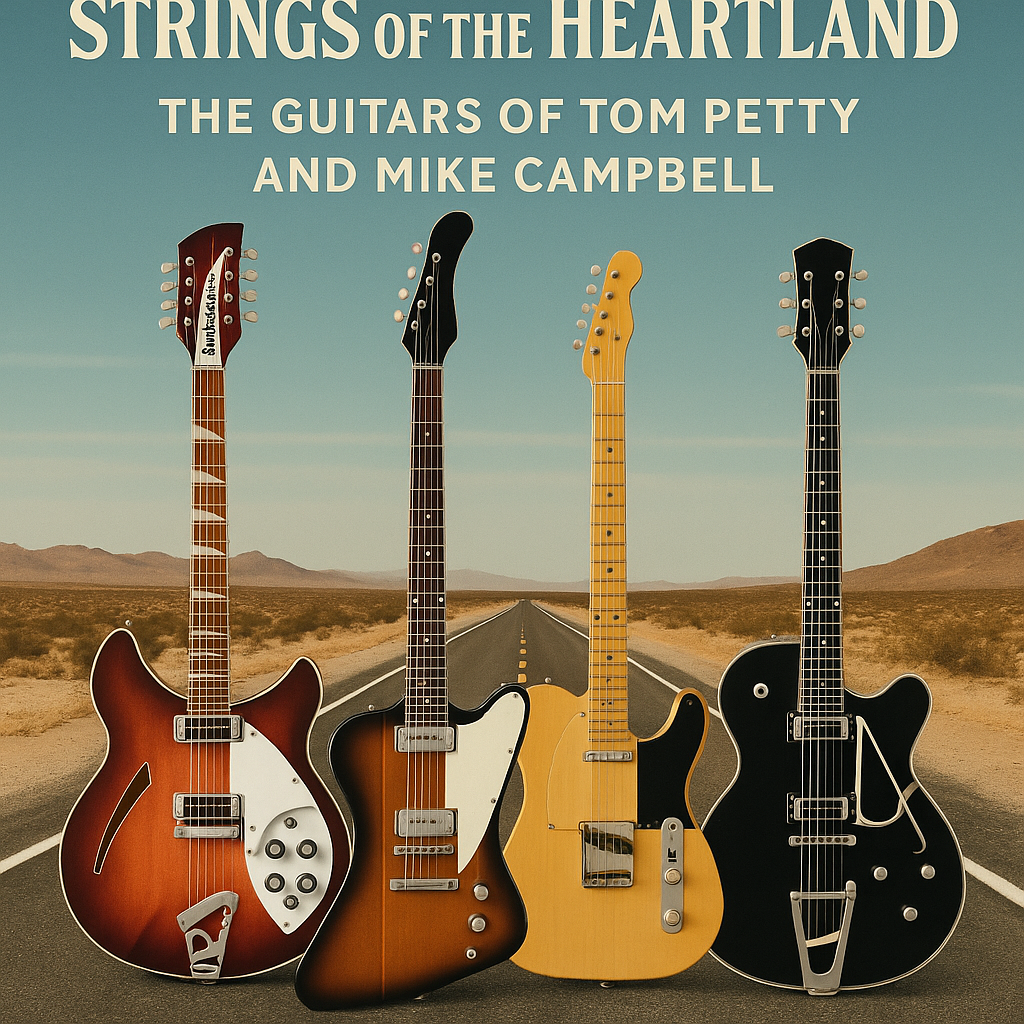Tom Petty and Mike Campbell formed one of the most enduring songwriting and guitar duos in rock history. Their sound—at once nostalgic and modern—was anchored by a carefully curated collection of vintage guitars that blended British Invasion jangle with American roots rock grit.
Here’s a breakdown of the key guitars that shaped their signature sound, and the legendary tracks they brought to life.
🎸 Tom Petty’s Guitars
1. 1964 Rickenbacker 360/12
Perhaps the most iconic guitar associated with Petty, the 12-string Rickenbacker 360 was a sonic and visual trademark.
-
Used On: “American Girl”, “Listen to Her Heart”, “The Waiting”
-
Sound: That unmistakable Byrds-inspired jangle—bright, chiming, and rich in harmonics.
-
Backstory: Petty was a huge Byrds fan, and Roger McGuinn’s influence can be heard clearly in both his playing and songwriting.
2. Fender Telecaster
Petty was often seen with various Telecasters, favouring their simplicity and bite.
-
Used On: Live performances of “Refugee”, “Even the Losers”
-
Sound: Bright, punchy, perfect for cutting through the mix on stage.
3. Gibson Dove Acoustic
A key songwriting companion for Petty, used in many studio sessions and videos.
-
Used On: Acoustic versions of “Free Fallin’”, “Wildflowers”
-
Sound: Warm, balanced tone ideal for introspective ballads.
4. Gretsch Tennessean
Used less frequently but prominently featured in Petty’s solo and Wilburys era.
-
Used On: “Handle With Care” (Traveling Wilburys)
-
Sound: Woody and retro, great for rhythm work and retro-leaning tracks.
🎸 Mike Campbell’s Guitars
Mike Campbell’s tone and taste made him the understated hero of the Heartbreakers. A connoisseur of vintage gear, Campbell wielded an arsenal of unique guitars to suit each song.
1. Gibson Firebird V
One of Campbell’s most beloved guitars, notable for its reverse body and mini-humbuckers.
-
Used On: “Refugee”, “You Got Lucky”
-
Sound: Thick, biting, with clear note definition.
-
Trivia: The iconic riff of “Refugee” was born on this guitar.
2. Fender Broadcaster
A pre-Telecaster relic that Campbell often brought out in the studio.
-
Used On: “Mary Jane’s Last Dance”
-
Sound: Woody and mid-focused with lots of vintage mojo.
3. Rickenbacker 12-String (360/12 and 620/12)
Like Petty, Campbell also embraced the Rickenbacker jangle.
-
Used On: “Here Comes My Girl”
-
Sound: Lush arpeggios and dreamy chord textures.
4. Duesenberg Starplayer TV
A more modern guitar Campbell used extensively in later years.
-
Used On: “Saving Grace”, “I Should Have Known It”
-
Sound: A blend of sparkle and punch with versatile switching options.
-
Fun Fact: Duesenberg even released a Mike Campbell signature model in his favourite racing stripe finish.
5. Gibson SG
Another favourite of Campbell’s for thick rock tones.
-
Used On: “Running Down a Dream”
-
Sound: Raw, fat tone with sustain for days—perfect for the song’s searing solos.
🎵 The Alchemy of Two Players
What made Petty and Campbell’s guitar chemistry so magical was their restraint and taste. Petty provided the steady rhythm, while Campbell painted color and texture—never overplaying, always serving the song.
From stadium anthems to tender ballads, their guitars weren’t just tools—they were co-conspirators in shaping a timeless catalog.
Final Thoughts:
Tom Petty and Mike Campbell didn’t chase trends. They built a sound rooted in the classic tones of the ‘60s and ‘70s, using guitars that told stories of their own. Their collection wasn’t about flash—it was about feel. And that feel resonates in every chord of Damn the Torpedoes, Wildflowers, and beyond.









